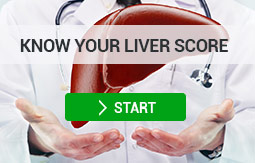Knowing how to prevent cirrhosis of the liver and how to recognize symptoms early on can help prevent progression of the liver disease or further damage if you have it. Read our article to learn about the causes, preventative measures, symptoms, consequences, diagnosis and treatment regarding liver cirrhosis.
What’s in this article?
- What is cirrhosis of the liver?
- Causes
- Prevention
- Symptoms
- Consequences
- Diagnosis
- Treatment
What is cirrhosis of the liver?
Cirrhosis of the liver is the extreme scarring of the liver and the loss of cells. The liver is the most important internal organ and performs over 500 vital tasks and functions. Cirrhosis is a long-term liver disease that usually results from prolonged inflammation. When the liver is continuously or repeatedly inflamed or injured, liver cells will try to repair themselves but may form scar tissue instead. These cells are not regenerated.
Causes
Liver cirrhosis can result from a viral infection or other pathogens that damage the liver, through autoimmune and genetic disorders, alcohol consumption, drug use, exposure to toxins, fatty liver disease, and hardening or scarring of the bile duct (the duct that transports bile, a fluid that aids digestion). To find out how healthy your lifestyle is for your liver, you can answer 12 simple multiple-choice questions to get your Liver Score results.
Liver Cirrhosis often stems from Liver fibrosis, the mild scarring of the liver. Early fibrosis can often be reversed, however, if left untreated for months or years, it can progress to advanced fibrosis, and eventually, cirrhosis, which is irreversible.
Prevention
You can take precautions to prevent the development of liver cirrhosis, such as limiting alcohol consumption, not taking prescription or over the counter medications, like ibuprofen, unless necessary, avoiding illicit drugs, maintaining a healthy weight through exercise and a healthy liver diet, and protecting yourself from hepatitis. Ways to protect yourself from hepatitis include: getting the hepatitis A or B vaccine, practicing good hygiene, avoiding unclean environments and always using a condom during sex.
Symptoms
Symptoms of liver cirrhosis include:
- fatigue
- weakness
- loss of appetite
- bruising more easily
- musty smelling breath
- red palms
- itchy skin
- jaundice (yellowing of the skin and whites of the eyes)
- multiple spider angiomas (an abnormal collection of blood vessels near the skin’s surface) that appear suddenly
- esophageal varices (abnormal, enlarged veins in the esophagus)
- ascites (the accumulation of fluid in the abdomen)
- decreased cognitive function (mental processes that help us collect and process information), such as attention, memory and language.
If you experience the above symptoms, speak with your physician as soon as possible.
Consequences
Liver cirrhosis can prevent the liver from functioning properly. Cirrhosis can progress into liver cancer, a coma, and portal hypertension, increased blood pressure in a group of veins called the portal venous system, which can cause varices (dilated blood vessels in the esophagus or stomach) to rupture and bleed, resulting in life-threatening conditions. Cirrhosis is the ninth leading cause of death in the U.S.
Diagnosis
The methods that can help diagnose liver cirrhosis are: noninvasive imaging techniques, like an ultrasound, as well as imaging techniques that measure the stiffness of the liver, like a FibroScan® test and an MRE (Magnetic Resonance Elastography) test, an endoscopy, a nonsurgical procedure that examines the body’s internal organs with an endoscope (a long and thin tube with a light and camera on one end), and a liver biopsy, an invasive procedure where a sample of liver tissue is removed for examination.
Treatment
Liver cirrhosis treatments differ based on the cause of the scarring. A liver healthy diet is vital for liver disease patients. While cirrhosis is incurable, behavioral changes, like giving up alcohol and cooking liver healthy recipes, can prevent further damage. Sometimes medication is prescribed, and in extreme cases, a liver transplant may be necessary.
Find out more about the basics of liver disease and liver functions with Dr. Tarek Hassanein, M.D.
References
www.amsety.com/fatty-liver-disease/
www.liverdirectory.com
medlineplus.gov
mayoclinic.org
study.com
nhs.uk

 (442) 244-5115
(442) 244-5115











